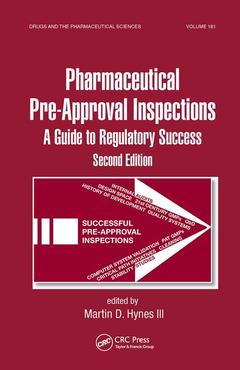Preparing for FDA Pre-Approval Inspections (2nd Ed.) A Guide to Regulatory Success, Second Edition
Coordonnateur : Hynes Martin D.

This Second Edition is an essential guide to preparing for FDA pre-approval inspections?taking into account current trends in FDA expectations and inspection activities, such as the GMPs of the 21st Century, quality systems-based approach to inspections, risk-based inspections, quality by design, process analytical technology, design space, etc. The goal of this book is to help organizations gain rapid regulatory approval.
Pharmaceutical Pre-Approval Inspections: A Guide to Regulatory Success, Second Edition:
- chronicles the major shifts in inspection activity as evidenced by a systems-based approach to inspections
- demonstrates what each area of pharmaceutical development, from research and development to training, is expected to provide to inspectors
- focuses on traditional development and submission activities, but also discusses cases where the transfer is from a domestic site to an international facility
Introduction/Preface. Pre-Approval Inspection: A Historical Overview. Recent Trends in Domestic and International Pre-Approval Inspections. The Implications of the Quality Systems, Risk Based Inspections and 21st Century GMPs to Preparing for FDA Pre-Approval Inspections. Preparing for FDA Pre-Approval Inspections Similarities and Differences between Center for Biologics Evaluation and Research (CBER) / Center for Drug Evaluation and Research (CDER). The GMP Risk Assessment, Guidance for Preparing for Pre-Approval Inspections, Traditional and Non-Traditional. The Product Development Drill, the Importance of Good Science, Stability Data, Scale Up, and Validation to Successfully Passing a Pre-Approval Inspection. The History of Development Documents: Guidance for Preparation in Light of Recent Trends. Computer Validation Systems Validation during the Drug Development Process. The Use of Audits during the Drug Development Process to Assure a Successful Pre-Approval Inspection. The Consequence of a Poor Product Development Process and Failing a Pre-Approval Inspection.
MARTIN D. HYNES III is Director of Product Research and Development and Six Sigma Champion at Lilly Research Laboratories, Eli Lilly and Company, Indianapolis, Indiana. Dr. Hynes has authored or co-authored numerous scientific articles, abstracts, book chapters, books, and patents. He is a member of a number of scientific and industry organizations. He has spoken and served as session chair at meetings of these organizations on numerous occasions. Dr. Hynes earned his bachelor’s degree in psychology from Providence College and his Ph.D. in pharmacology and toxicology from the University of Rhode Island. After completing a post-doctoral fellowship at the Roche Institute of Molecular Biology, he joined Lilly Research Labs. He has held several management positions, including Director of Pharmaceutical Project Management, Director of Quality Assurance, and Director for Clinical Research for Eli Lilly, Japan.
Date de parution : 12-2019
15.2x22.9 cm
Date de parution : 03-2008
Ouvrage de 304 p.
15.2x22.9 cm
Thème de Preparing for FDA Pre-Approval Inspections :
Mots-clés :
Moisture Vapor Transmission Rate; Laboratory Information Management System; pharmaceutical research; Pre-Approval Inspections; risk-based inspections; Preapproval Inspection; quality systems-based approach; Moisture Content; process analytical technology; Dry Blend Process; FDA's expectations; Job Function; CMC Section; FDA Expectation; Drug Substance; Clinical Trial Materials; FDA Inspection; CMC Information; Performance Assessment; Dosage Form; Pat Guidance; Master Batch Records; Risk Based Approach; Validation Master Plan; Successful Training Strategy; Ich Q1A; Direct Surface Sampling; Equipment Cleaning; Compliance Gaps; Roller Compaction
